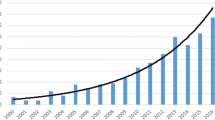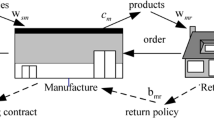Abstract
Supply chain (SC) uncertainties are present in both the demand and supply sides of the chain. If these uncertainties are not countered appropriately, the customer service level (CSL) and customer satisfaction will decrease, and this, in turn, will lead to a loss of sales volume and SC profitability. Maintaining an appropriate level of safety stock as a counteracting solution to SC uncertainties can boost the CSL. In traditional decision making, the retailer determines the CSL by determining its own safety stock level. However, the CSL affects the sales volume and profitability of the upstream members. This paper investigates the joint decision making on CSL in a two-stage SC with a constraint on the retailer's order size to analyze the benefits of coordination and cooperation when determining the CSL. The results of this study show that CSL coordination can significantly increase the profitability of the SC.
Similar content being viewed by others
References
Gupta A, Maranas CD (2003) Managing demand uncertainty in supply chain planning. Comput Chem Eng 27:1219–1227
Silver EA, Pyke DF, Peterson R (1998) Inventory management and production planning and scheduling, 3rd edn. Wiley, New York
Graves SC, Willems SP (2000) Optimizing strategic safety stock placement in supply chains. Manuf Serv Oper Manag 2(1):68–83
Chen F (2000) Optimal policies for multi-echelon inventory problems with batch ordering. Oper Res 48(3):376–389
Chen F (1998) Echelon reorder points, installation reorder points, and the value of centralized demand information. Manag Sci 44(12):S221–S234
Govil M, Proth JM (2002) Supply chain design and management: strategic and tactical perspectives. Academic, Florida
Li X, Wang Q (2007) Coordination mechanism of supply chain systems. Eur J Oper Res 179(1):1–16
Giannoccaro I, Pontrandolfo P (2004) Supply chain coordination by revenue sharing contracts. Int J Prod Econ 89:131–139
Whang S (1995) Coordination in operations: a taxonomy. J Oper Manag 12:413–422
Li J, Liu L (2006) Supply chain coordination with quantity discount policy. Int J Prod Econ 101:89–98
Rau H, OuYang BC (2008) An optimal batch size for integrated production-inventory policy in a supply chain. Eur J Oper Res 185:619–634
Chung CJ, Wee HM (2007) Optimizing the economic lot size of a three-stage supply chain with backordering derived without derivatives. Eur J Oper Res 183:933–943
Arshinder K, Kanda A, Deshmukh SG (2006) A graph theoretic approach for supply chain coordination. Int J Logist Syst Manag 2(4):321–341
Arshinder K, Kanda A, Deshmukh SG (2007) Supply chain coordination issues: an SAP-LAP framework. Asia Pac J Mark Log 19(3):240–264
Yue J, Austin J, Wang MC, Huang Z (2006) Coordination of cooperative advertising in a two-level supply chain when manufacturer offers discount. Eur J Oper Res 168:65–85
Inderfurth K (1991) Safety stock optimization in multi-stage inventory systems. Int J Prod Econ 24(1–2):103–113
Inderfurth K, Minner S (1998) Safety stocks in multi-stage inventory systems under different service measures. Eur J Oper Res 106(1):57–73
Graves SC, Willems SP (2008) Strategic inventory placement in supply chains: nonstationary demand. Manuf Serv Oper Manag 10(2):278–287
Simchi-Levi D, Zhao Y (2005) Safety stock positioning in supply chains with stochastic lead times. Manuf Serv Oper Manag 7(4):295–318
Vanteddu G, Chinnam RB, Yang K, Gushikin O (2007) Supply chain focus dependent safety stock placement. Int J Flex Manuf Syst 19:463–485
Man-Yi T, Xiao-Wo T (2006) The further study of safety stock under uncertain environment. Fuzzy Optim Decis Making 5:193–202
Yue X (2007) The impact of operations redesign on the safety stock investment in supply chains. Int J Flex Manuf Syst 19:516–532
Boulaksil Y, Fransoo JC, van Halm ENG (2009) Setting safety stocks in multi-stage inventory systems under rolling horizon mathematical programming models. OR Spectrum 31:121–140
Bossert JM, Willems SP (2007) A periodic-review modeling approach for guaranteed service supply chains. Interfaces 37(5):420–435
Axsäter S (2003) Note: optimal policies for serial inventory systems under fill rate constraints. Manag Sci 49(2):247–253
Paschalidis ICH, Liu Y, Cassandras CG, Panayiotou C (2004) Inventory control for supply chains with service level constraints: a synergy between large deviations and perturbation analysis. Ann Oper Res 126:231–258
Cachon GP, Zipkin PH (1999) Competitive and cooperative inventory policies in a two-stage supply chain. Manag Sci 45(7):936–953
Cachon GP (2001) Stock wars: inventory competition in a two-echelon supply chain with multiple retailers. Oper Res 49(5):658–674
Arshinder K, Kanda A, Deshmukh SG (2008) Supply chain coordination: perspectives, empirical studies and research directions. Int J Prod Econ 115(2):316–335
Author information
Authors and Affiliations
Corresponding author
Rights and permissions
About this article
Cite this article
Chaharsooghi, S.K., Heydari, J. Optimum coverage of uncertainties in a supply chain with an order size constraint. Int J Adv Manuf Technol 47, 283–293 (2010). https://doi.org/10.1007/s00170-009-2195-4
Received:
Accepted:
Published:
Issue Date:
DOI: https://doi.org/10.1007/s00170-009-2195-4




